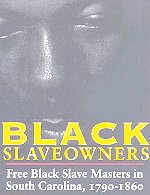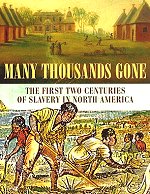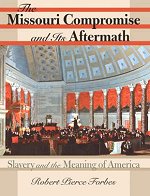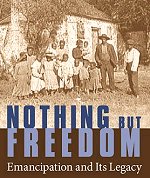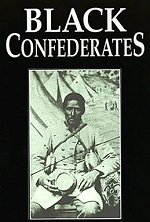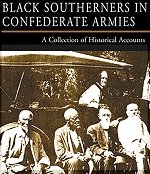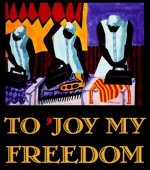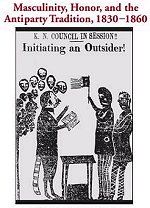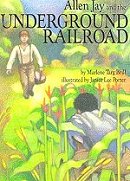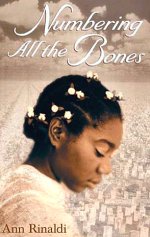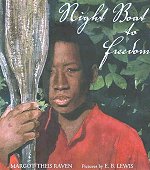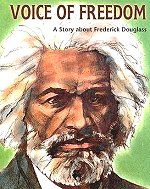| In an 1856 letter to his wife Mary Custis Lee, Robert E. Lee called slavery "a moral and political evil." Yet he concluded that black slaves were immeasurably better off here than in Africa, morally, socially and physically.
The fact is large numbers of free Negroes owned black slaves; in fact, in numbers disproportionate to their representation in society at large. In 1860 only a small minority of whites owned slaves. According to the U.S. census report for that last year before the Civil War, there were nearly 27 million whites in the country. Some eight million of them lived in the slaveholding states.
The census also determined that there were fewer than 385,000 individuals who owned slaves (1). Even if all slaveholders had been white, that would amount to only 1.4 percent of whites in the country (or 4.8 percent of southern whites owning one or more slaves).
In the rare instances when the ownership of slaves by free Negroes is acknowledged in the history books, justification centers on the claim that black slave masters were simply individuals who purchased the freedom of a spouse or child from a white slaveholder and had been unable to legally manumit them. Although this did indeed happen at times, it is a misrepresentation of the majority of instances, one which is debunked by records of the period on blacks who owned slaves. These include individuals such as Justus Angel and Mistress L. Horry, of Colleton District, South Carolina, who each owned 84 slaves in 1830. In fact, in 1830 a fourth of the free Negro slave masters in South Carolina owned 10 or more slaves; eight owning 30 or more (2).
According to federal census reports, on June 1, 1860 there were nearly 4.5 million Negroes in the United States, with fewer than four million of them living in the southern slaveholding states. Of the blacks residing in the South, 261,988 were not slaves. Of this number, 10,689 lived in New Orleans. The country's leading African American historian, Duke University professor John Hope Franklin, records that in New Orleans over 3,000 free Negroes owned slaves, or 28 percent of the free Negroes in that city.
To return to the census figures quoted above, this 28 percent is certainly impressive when compared to less than 1.4 percent of all American whites and less than 4.8 percent of southern whites. The statistics show that, when free, blacks disproportionately became slave masters.
The majority of slaveholders, white and black, owned only one to five slaves. More often than not, and contrary to a century and a half of bullwhips-on-tortured-backs propaganda, black and white masters worked and ate alongside their charges; be it in house, field or workshop. The few individuals who owned 50 or more slaves were confined to the top one percent, and have been defined as slave magnates.
In 1860 there were at least six Negroes in Louisiana who owned 65 or more slaves The largest number, 152 slaves, were owned by the widow C. Richards and her son P.C. Richards, who owned a large sugar cane plantation. Another Negro slave magnate in Louisiana, with over 100 slaves, was Antoine Dubuclet, a sugar planter whose estate was valued at (in 1860 dollars) $264,000 (3). That year, the mean wealth of southern white men was $3,978 (4).
In Charleston, South Carolina in 1860 125 free Negroes owned slaves; six of them owning 10 or more. Of the $1.5 million in taxable property owned by free Negroes in Charleston, more than $300,000 represented slave holdings (5). In North Carolina 69 free Negroes were slave owners (6).
In 1860 William Ellison was South Carolina's largest Negro slaveowner. In Black Masters. A Free Family of Color in the Old South, authors Michael P. Johnson and James L. Roak write a sympathetic account of Ellison's life. From Ellison's birth as a slave to his death at 71, the authors attempt to provide justification, based on their own speculation, as to why a former slave would become a magnate slave master.
At birth he was given the name April. A common practice among slaves of the period was to name a child after the day or month of his or her birth. Between 1800 and 1802 April was purchased by a white slave-owner named William Ellison. Apprenticed at 12, he was taught the trades of carpentry, blacksmithing and machining, as well as how to read, write, cipher and do basic bookkeeping.
On June 8, 1816, William Ellison appeared before a magistrate (with five local freeholders as supporting witnesses) to gain permission to free April, now 26 years of age. In 1800 the South Carolina legislature had set out in detail the procedures for manumission. To end the practice of freeing unruly slaves of "bad or depraved" character and those who "from age or infirmity" were incapacitated, the state required that an owner testify under oath to the good character of the slave he sought to free. Also required was evidence of the slave's "ability to gain a livelihood in an honest way."
Although lawmakers of the time could not envision the incredibly vast public welfare structures of a later age, these stipulations became law in order to prevent slaveholders from freeing individuals who would become a burden on the general public.
Interestingly, considering today's accounts of life under slavery, authors Johnson and Roak report instances where free Negroes petitioned to be allowed to become slaves; this because they were unable to support themselves.
Black Confederates and Afro-Yankees in Civil War Virginia (University Press of Virginia-1995) was written by Ervin L. Jordan Jr., an African-American and assistant professor and associate curator of the Special Collections Department, University of Virginia library. He wrote: "One of the more curious aspects of the free black existence in Virginia was their ownership of slaves. Black slave masters owned members of their family and freed them in their wills. Free blacks were encouraged to sell themselves into slavery and had the right to choose their owner through a lengthy court procedure."
In 1816, shortly after his manumission, April moved to Stateburg. Initially he hired slave workers from local owners. When in 1817 he built a gin for Judge Thomas Watries, he credited the judge nine dollars "for hire of carpenter George for 12 days." By 1820 he had purchased two adult males to work in his shop (7). In fewer than four years after being freed, April demonstrated that he had no problem perpetuating an institution he had been released from. He also achieved greater monetary success than most white people of the period.
On June 20, 1820, April appeared in the Sumter District courthouse in Sumterville. Described in court papers submitted by his attorney as a "freed yellow man of about 29 years of age," he requested a name change because it "would yet greatly advance his interest as a tradesman." A new name would also "save him and his children from degradation and contempt which the minds of some do and will attach to the name April." Because "of the kindness" of his former master and as a "Mark of gratitude and respect for him" April asked that his name be changed to William Ellison. His request was granted.
In time the black Ellison family joined the predominantly white Episcopalian church. On August 6, 1824 he was allowed to put a family bench on the first floor, among those of the wealthy white families. Other blacks, free and slave, and poor whites sat in the balcony. Another wealthy Negro family would later join the first floor worshippers.
Between 1822 and the mid-1840s, Ellison gradually built a small empire, acquiring slaves in increasing numbers. He became one of South Carolina's major cotton gin manufacturers, selling his machines as far away as Mississippi. From February 1817 until the War Between the States commenced, his business advertisements appeared regularly in newspapers across the state. These included the Camden Gazette, the Sumter Southern Whig and the Black River Watchman.
Ellison was so successful, due to his utilization of cheap slave labor, that many white competitors went out of business. Such situations discredit impressions that whites dealt only with other whites. Where money was involved, it was apparent that neither Ellison's race or former status were considerations.
In his book, Ervin L. Jordan Jr. writes that, as the great conflagration of 1861-1865 approached: "Free Afro-Virginians were a nascent black middle class under siege, but several acquired property before and during the war. Approximately 169 free blacks owned 145,976 acres in the counties of Amelia, Amherst, Isle of Wight, Nansemond, Prince William and Surry, averaging 870 acres each. Twenty-rune Petersburg blacks each owned property worth $1,000 and continued to purchase more despite the war."
Jordan offers an example: "Gilbert Hunt, a Richmond ex-slave blacksmith, owned two slaves, a house valued at $1,376, and $500 in other properties at his death in 1863." Jordan wrote that "some free black residents of Hampton and Norfolk owned property of considerable value; 17 black Hamptonians possessed property worth a total of $15,000. Thirty-six black men paid taxes as heads of families in Elizabeth City County and were employed as blacksmiths, bricklayers, fishermen, oystermen and day laborers. In three Norfolk County parishes 160 blacks owned a total of $41,158 in real estate and personal property.
The general practice of the period was that plantation owners would buy seed and equip~ ment on credit and settle their outstanding accounts when the annual cotton crop was sold. Ellison, like all free Negroes, could resort to the courts for enforcement of the terms of contract agreements. Several times Ellison successfully sued white men for money owed him.
In 1838 Ellison purchased on time 54.5 acres adjoining his original acreage from one Stephen D. Miller. He moved into a large home on the property. What made the acquisition notable was that Miller had served in the South Carolina legislature, both in the U.S. House of Representatives and the Senate, and while a resident of Stateburg had been governor of the state. Ellison's next door neighbor was Dr. W.W. Anderson, master of "Borough House, a magnificent 18th Century mansion. Anderson's son would win fame in the War Between the States as General "Fighting Dick" Anderson.
By 1847 Ellison owned over 350 acres, and more than 900 by 1860. He raised mostly cotton, with a small acreage set aside for cultivating foodstuffs to feed his family and slaves. In 1840 he owned 30 slaves, and by 1860 he owned 63. His sons, who lived in homes on the property, owned an additional nine slaves. They were trained as gin makers by their father (8). They had spent time in Canada, where many wealthy American Negroes of the period sent their children for advanced formal education. Ellison's sons and daughters married mulattos from Charleston, bringing them to the Ellison plantation to live.
In 1860 Ellison greatly underestimated his worth to tax assessors at $65,000. Even using this falsely stated figure, this man who had been a slave 44 years earlier had achieved great financial success. His wealth outdistanced 90 percent of his white neighbors in Sumter District. In the entire state, only five percent owned as much real estate as Ellison. His wealth was 15 times greater than that of the state's average for whites. And Ellison owned more slaves than 99 percent of the South's slaveholders.
Although a successful businessman and cotton farmer, Ellison's major source of income derived from being a "slave breeder." Slave breeding was looked upon with disgust throughout the South, and the laws of most southern states forbade the sale of slaves under the age of 12. In several states it was illegal to sell inherited slaves (9). Nevertheless, in 1840 Ellison secretly began slave breeding.
While there was subsequent investment return in raising and keeping young males, females were not productive workers in his factory or his cotton fields. As a result, except for a few females he raised to become "breeders," Ellison sold the female and many of the male children born to his female slaves at an average price of $400. Ellison had a reputation as a harsh master. His slaves were said to be the district's worst fed and clothed. On his property was located a small, windowless building where he would chain his problem slaves.
As with the slaves of his white counterparts, occasionally Ellison's slaves ran away. The historians of Sumter District reported that from time to time Ellison advertised for the return of his runaways. On at least one occasion Ellison hired the services of a slave catcher. According to an account by Robert N. Andrews, a white man who had purchased a small hotel in Stateburg in the 1820s, Ellison hired him to run down "a valuable slave. Andrews caught the slave in Belleville, Virginia. He stated: "I was paid on returning home $77.50 and $74 for expenses.
William Ellison died December 5, 1861. His will stated that his estate should pass into the joint hands of his free daughter and his two surviving sons. He bequeathed $500 to the slave daughter he had sold.
Following in their father's footsteps, the Ellison family actively supported the Confederacy throughout the war. They converted nearly their entire plantation to the production of corn, fodder, bacon, corn shucks and cotton for the Confederate armies. They paid $5,000 in taxes during the war. They also invested more than $9,000 in Confederate bonds, treasury notes and certificates in addition to the Confederate currency they held. At the end, all this valuable paper became worthless.
The younger Ellisons contributed more than farm produce, labor and money to the Confederate cause. On March 27, 1863 John Wilson Buckner, William Ellison's oldest grandson, enlisted in the 1st South Carolina Artillery. Buckner served in the company of Captains P.P. Galliard and A.H. Boykin, local white men who knew that Buckner was a Negro. Although it was illegal at the time for a Negro to formally join the Confederate forces, the Ellison family's prestige nullified the law in the minds of Buckner's comrades. Buckner was wounded in action on July 12, 1863. At his funeral in Stateburg in August, 1895 he was praised by his former Confederate officers as being a "faithful soldier."
Following the war the Ellison family fortune quickly dwindled. But many former Negro slave magnates quickly took advantage of circumstances and benefited by virtue of their race. For example Antoine Dubuclet, the previously mentioned New Orleans plantation owner who held more than 100 slaves, became Louisiana state treasurer during Reconstruction, a post he held from 1868 to 1877 (10).
A truer picture of the Old South, one never presented by the nation's mind molders, emerges from this account. The American South had been undergoing structural evolutionary changes far, far greater than generations of Americans have been led to believe. In time, within a relatively short time, the obsolete and economically nonviable institution of slavery would have disappeared. The nation would have been spared awesome traumas from which it would never fully recover.
NOTES
1. The American Negro: Old World Background and New World Experience, Raymond Logan and Irving Cohen New York: Houghton and Mifflin, 1970), p.72.
2. Black Masters: A Free Family of Color in the Old South, Michael P. Johnson and James L. Roak New York: Norton, 1984), p.64.
3. The Forgotten People: Cane River's Creoles of Color, Gary Mills (Baton Rouge, 1977); Black Masters, p.128.
4. Male inheritance expectations in the United States in 1870, 1850-1870, Lee Soltow (New Haven, 1975), p.85.
5. Black Masters, Appendix, Table 7; p.280.
6. Black Masters, p. 62.
7. Information on the Ellison family was obtained from Black Masters; the number of slaves they owned was gained from U.S. Census Reports.
8. In 1860 South Carolina had only 21 gin makers; Ellison, his three sons and a grandson account for five of the total.
9. Neither Black Nor White: Slavery and Race Relations in Brazil and the United States, Carl N. Degler (New York, Macmillan, 1971), p.39;
Negro Slavery in Louisiana, Joe Gray Taylor (Baton Rouge, 1963), pp. 4041.
10. Reconstruction: America's Unfinished Revolution, 1863-1877, Eric Foner (New York; Harper & Row, 1988), p. 47; pp. 353-355.
|
